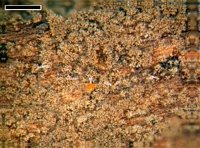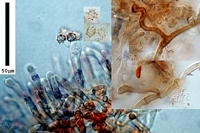|
 Tomentella ferruginea Tomentella ferruginea
SynonymsTomentella fusca
Corticium ferrugineum
Corticium fuscum
Hypochnus fuscus
Thelephora fusca
BiostatusPresent in region - Indigenous. Non endemic
Images (click to enlarge)
Caption: scale=0.5mm
Owner: J.A. Cooper | 
Owner: J.A. Cooper |
Article: Cunningham, G.H. (1963). The Thelephoraceae of Australia and New Zealand. New Zealand Department of Scientific and Industrial Research, Bulletin 145: 359 p. Wellington:.
Description: Hymenophore annual, sometimes biennial, membranous,
loosely attached, effused forming irregularly orbicular or elliptical areas to
10 x 7 cm; hymenial surface ferruginous, dark umber or chocolate, often with a
vinaceous tinge, even, slightly punctate under a lens, not creviced; margin
thinning out, concolorous, arachnoid, loosely attached. Context ferruginous,
400-650 µm thick, basal layer of mainly parallel hyphae, intermediate layer well
developed, of mainly erect hyphae; generative hyphae 4-6 µm diameter, walls 0.25
µm thick, clear brown, branched at a wide angle, freely septate save in the
basal hyphae where septa are widely spaced, with clamp connections. Hymenial
layer to 80 µm deep, a close palisade of basidia and paraphyses. Basidia
subclavate, 40-56 x 8-10 µm, bearing 2-4 spores; sterigmata arcuate, to 10 µm
long. Paraphyses subclavate, 25-48 x 5-7 µm. Spores globose, subglobose,
obovate, or oval, 9-12 x 8-10 µm (a few to 14 x 10 µm), apiculate, walls
sinuate, sparsely coarsely aculeate, ferruginous, 0.25-0.5 µm thick, spines to
1.5 µm long.
Habitat: HABITAT: Bark or decorticated wood of dead branches.
Distribution: DISTRIBUTION: Europe, North America, New Zealand.
Notes: Spores are slightly larger than those of authentic
European specimens examined, but in other features collections agree. Specific
features are the dark colour of the hymenial surface which is often chocolate
and tinted vinaceous, loose attachment of fructifications, absence of cordons,
and coarsely aculeate, sinuate spore walls of a colour similar to the context
hyphae. Spores bear a prominent apiculus, which may be obscured by the coarse
aculeae.
|